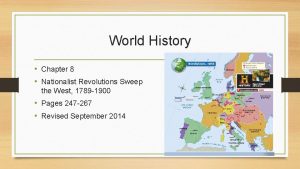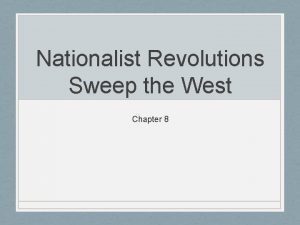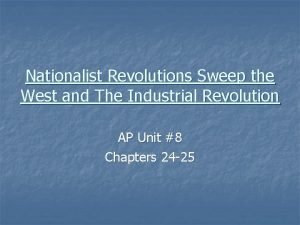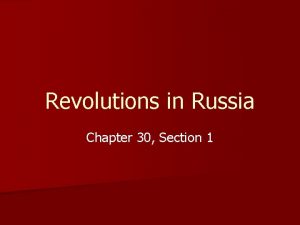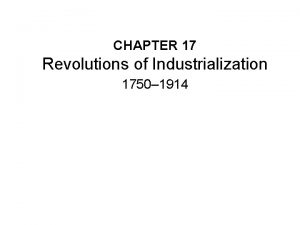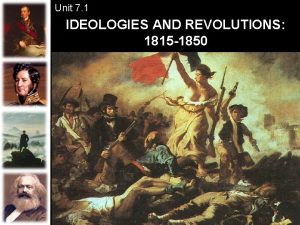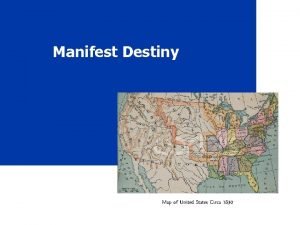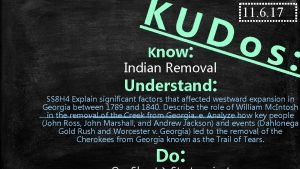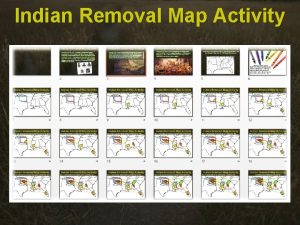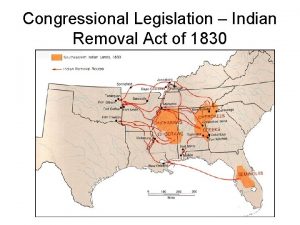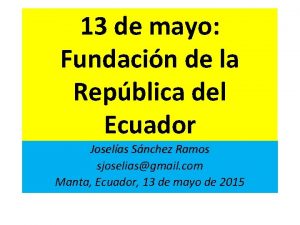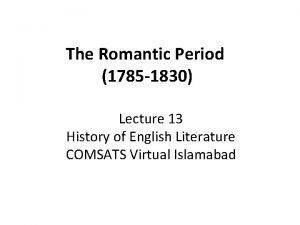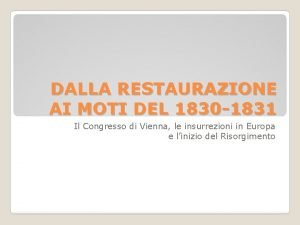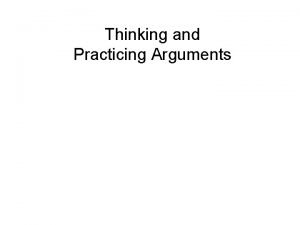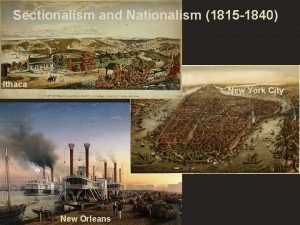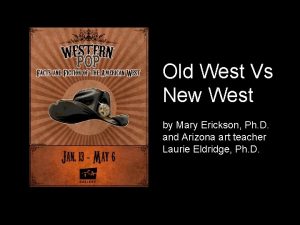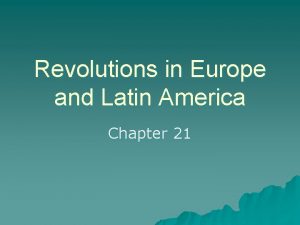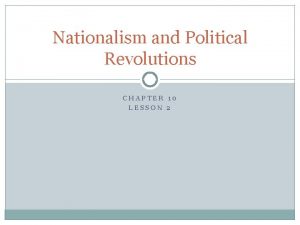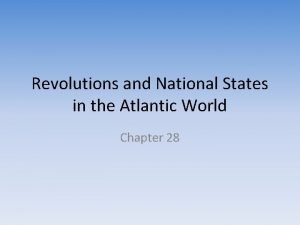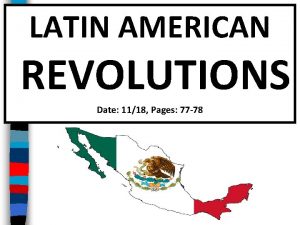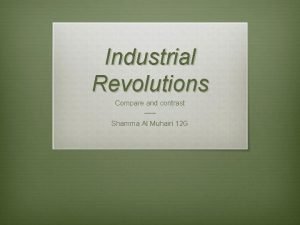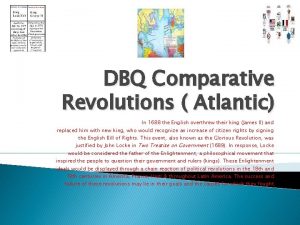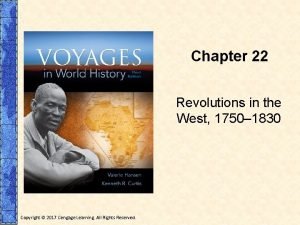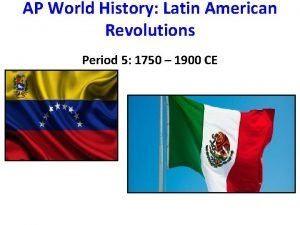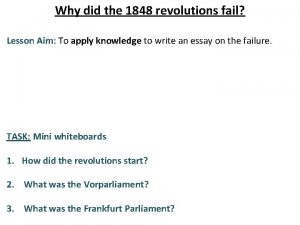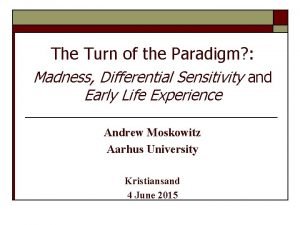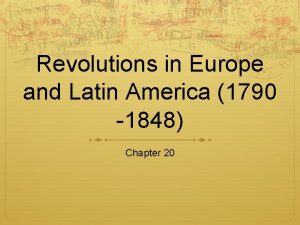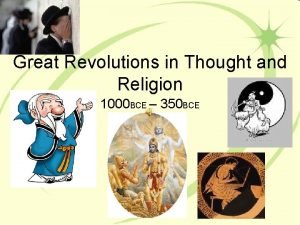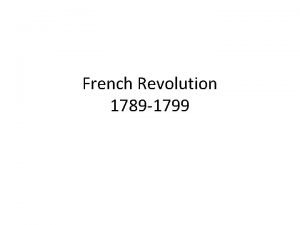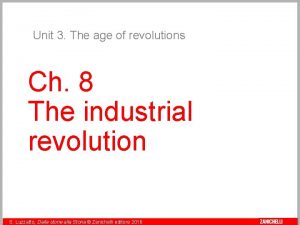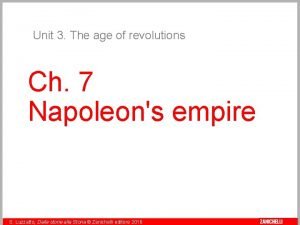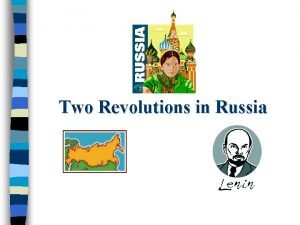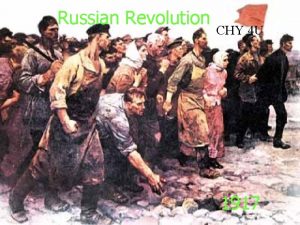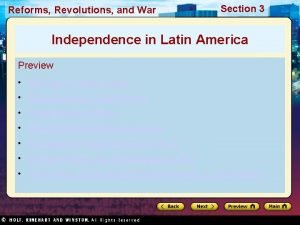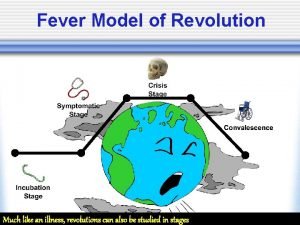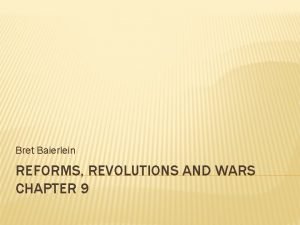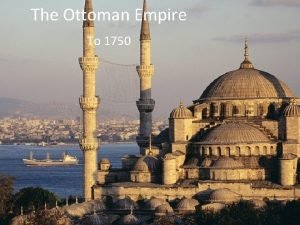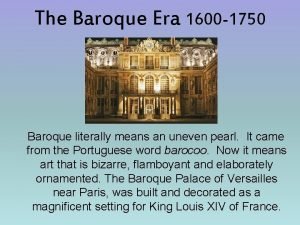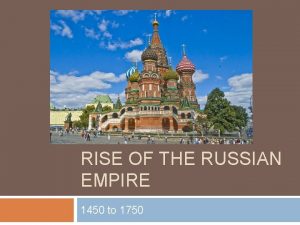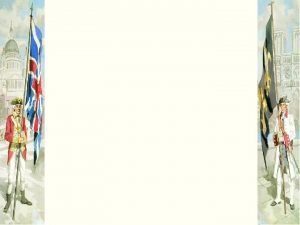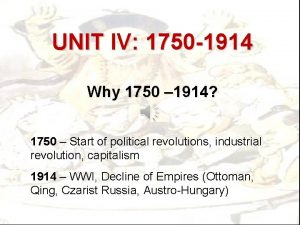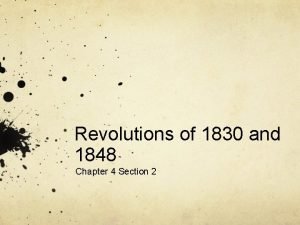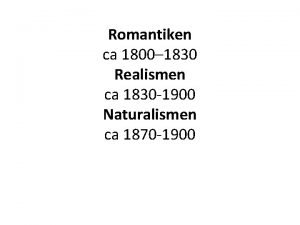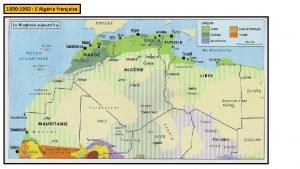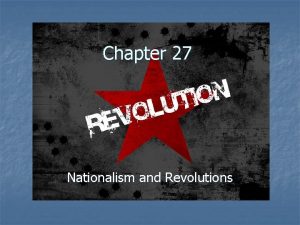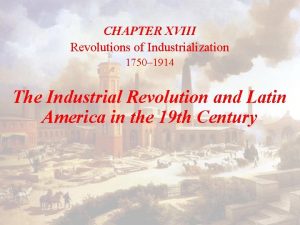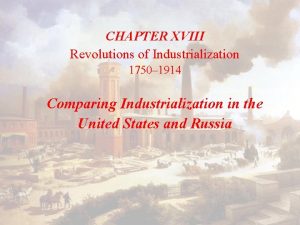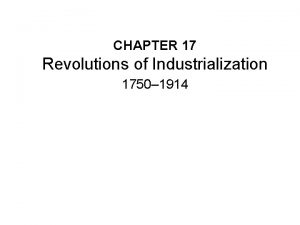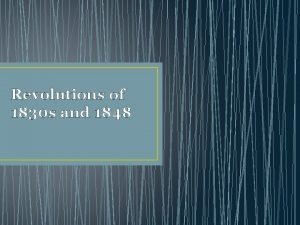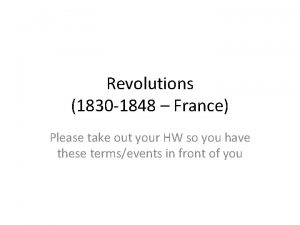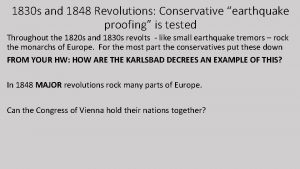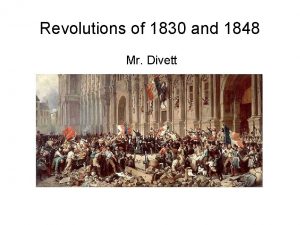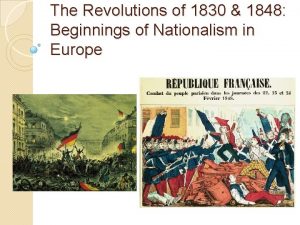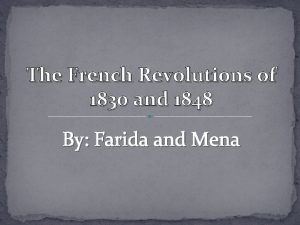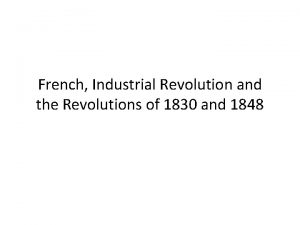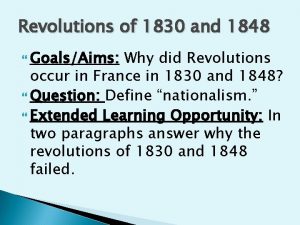Chapter 22 Revolutions in the West 1750 1830





































































- Slides: 69

Chapter 22 Revolutions in the West, 1750– 1830 Copyright © 2017 Cengage Learning. All Rights Reserved.

Learning Objectives (Slide 1 of 5) ▪ ▪ Describe the increasing tensions between the British authorities and the American colonists in the 1760 s over taxes and colonial self-rights Outline the advantages and disadvantages of the British and colonial armies Copyright © 2017 Cengage Learning. All Rights Reserved.

Learning Objectives (Slide 2 of 5) ▪ ▪ ▪ Discuss the constitutional compromises made by leaders of the new United States and the consequences for liberty and equality Identify the major phases of the French Revolution Summarize the Enlightenment ideas that inspired the French Revolution and influenced different social classes in France Copyright © 2017 Cengage Learning. All Rights Reserved.

Learning Objectives (Slide 3 of 5) ▪ ▪ ▪ Identify the Jacobins, their intentions of changing France during the Revolution, and the role of violence in the French Revolution Summarize Napoleon’s rise to power and his eventual fall Explain how earlier conditions of colonialism affected the course and outcome of revolutions in Latin America and the Caribbean Copyright © 2017 Cengage Learning. All Rights Reserved.

Learning Objectives (Slide 4 of 5) ▪ ▪ Discuss the role of Boukman and Toussaint L’Ouverture in the Haitian revolution and Francisco Miranda and Simón Bolivar in South American independence Explain the class and race divisions in South America and how they affected the revolutions for independence Copyright © 2017 Cengage Learning. All Rights Reserved.

Learning Objectives (Slide 5 of 5) ▪ Demonstrate how the revolutions in western Europe and the Americas transformed existing political and social structures Copyright © 2017 Cengage Learning. All Rights Reserved.

Introduction ▪ Simón Bolívar vowed to help liberate South America from the Spanish empire ▪ Bolívar traveled to Europe and was inspired by the French revolution ▪ ▪ ▪ Studied Enlightenment ideas in Paris Bolívar returned to Caracas in 1813 at the head of an army of liberation By 1824, he had driven the Spanish out of Peru Copyright © 2017 Cengage Learning. All Rights Reserved.

Simón Bolívar was a revolutionary who was born in Venezuela and led military forces throughout presentday Ecuador, Colombia, Bolivia, and Peru, becoming the most important military leader in the struggle for independence in South America. Copyright © 2017 Cengage Learning. All Rights Reserved.

The Travels of Simón Bolívar Copyright © 2017 Cengage Learning. All Rights Reserved.

Tea, Taxes, and The American Revolution: Crash Course World History #28

Rebellion and Independence in America, 1763– 1797 ▪ Rebellion and war, 1763– 1783 ▪ Seven Years’ War (1756– 1763) increased tensions between British and colonists ▪ ▪ Led to British taking over former French territory British authorities imposed new taxes ▪ Stamp Act of 1765 Stamp Act Crash Course Copyright © 2017 Cengage Learning. All Rights Reserved.

Rebellion and War, 1763– 1783 (Slide 1 of 5) ▪ Colonists resented new taxes and trade restrictions ▪ Forms of resistance ▪ ▪ Griot B - Party's Going On (Boston Tea Party Smuggled tea illegally Rap) Protested publicly Rallied to the slogan “no taxation without representation” Formed militias Boston Tea Party Colonists Protest British Policies Copyright © 2017 Cengage Learning. All Rights Reserved.

Protesting Taxation Needing additional resources to control its expanded American frontier after victory in the Seven Years’ War, the British Parliament imposed new taxes on the North American colonies. In this engraving, angry colonists have tarred and feathered one of the king’s officials beneath a “Liberty Tree. ” Tarring and feathering, which often left the victim permanently disfigured, was an exceptionally violent form of vigilante justice. Copyright © 2017 Cengage Learning. All Rights Reserved.

Rebellion and War, 1763– 1783 (Slide 2 of 5) ▪ Colonists convened a Continental Congress with representatives from thirteen colonies George Washington was appointed commander of its army ▪ On July 4, 1776, Congress approved Thomas Jefferson’s Declaration of Independence America the ▪ George Washington nominated as the Commander of the Continental Army Story of Us: Declaration ▪of Independence | History HISTORY Verified • 572 K views The Declaration listed the colonists’ grievances and stated the universal political values the colonists claimed to follow Copyright © 2017 Cengage Learning. All Rights Reserved. John Adams - Declaration of Independence

Rebellion and War, 1763– 1783 (Slide 3 of 5) ▪ British army had several advantages when the war began in 1776 ▪ ▪ ▪ A significant minority of colonial Loyalists wanted compromise rather than confrontation Many free blacks fought with the Loyalists Mohawk nation supported the British Military Advantage - American Revolutionary War Turn Meet Benedict Arnold Copyright © 2017 Cengage Learning. All Rights Reserved.

Rebellion and War, 1763– 1783 (Slide 4 of 5) ▪ Advantages of the Colonial Continental Army ▪ ▪ French supported the revolutionaries Colonies’ rural population supported the Continental Army Women took on traditional male roles so men were free to go fight George Washington proved a particularly capable leader The Patriot - Yorktown Siege & British Surrender Copyright © 2017 Cengage Learning. All Rights Reserved. A Look at the Series: TURN: Washington's Spies

Rebellion and War, 1763– 1783 (Slide 5 of 5) ▪ Washington surrounded the British at Yorktown in 1781 ▪ ▪ French ships cut off the British retreat Lord Cornwallis, the British commander, surrendered to Washington Treaty of Paris ended the war in 1783 British acknowledged the independence of the United States of America TURN: Washington's Spies: ‘The Surrender’ Talked About Scene Ep. 409 Copyright © 2017 Cengage Learning. All Rights Reserved.

Creating a Nation, 1783– 1797 (Slide 1 of 5) ▪ Founders saw the birth of their nation as an event that would usher in a new era ▪ ▪ Early motto of the new republic was Novus Ordo Secolorum, “A New Order of the Ages” Each of the thirteen states was reluctant to surrender its local power to a new federal government ▪ Under the Articles of Confederation, the federal government had no rights of taxation Articles of Confederation (Kelis's and no army "Milkshake" Parody) What Were the Articles of Confederation? | History Copyright © 2017 Cengage Learning. All Rights Reserved. @Mr. Betts. Class

Creating a Nation, 1783– 1797 (Slide 2 of 5) ▪ In 1787, the Constitutional Convention attempted to balance the powers of government—state and federal—with rights of individuals ▪ Also determined to balance the rights of state and federal governments Introduction to the Constitutional Convention Copyright © 2017 Cengage Learning. All Rights Reserved.

Creating a Nation, 1783– 1797 (Slide 3 of 5) ▪ In 1789, the convention drew up the Constitution of the United States of America Granted the federal government powers of taxation, judicial oversight, banking, diplomacy, and warfare ▪ Ensured a separation of executive, legislative, and judicial authority through checks and balances ▪ Prevented large states from overwhelming small states Copyright © 2017 Cengage Learning. All Rights Reserved. ▪ School House Rock -The Preamble The Constitution, the Articles, and Federalism: Crash Course US History #8

Creating a Nation, 1783– 1797 (Slide 4 of 5) ▪ In 1791, the Constitution was amended by the Bill of Rights ▪ Guaranteed specific civil liberties, such as freedom of religion, of the press, of assembly, and other fundamental freedoms ▪ However, no political agency was given to women, Native Americans, slaves, or free blacks Griot B - Bill O' Rights feat. Young Mike Copyright © 2017 Cengage Learning. All Rights Reserved.

Creating a Nation, 1783– 1797 (Slide 5 of 5) ▪ George Washington was the unanimous choice as president in 1789 ▪ ▪ Washington modeled his political career on the Roman general Cincinnatus (temp power) Constitutional Convention did not resolve the debate between full personal liberty and the right to own slaves George Washington: The First President of the United States | Biography Copyright © 2017 Cengage Learning. All Rights Reserved. A Modern Day Cincinnatus

Portraits of Power: George Washington Cincinatus Washington identified himself with the democratic tradition of Athens and the republican period of Rome. Copyright © 2017 Cengage Learning. All Rights Reserved.


Portraits of Power: George Washington and Napoleon Bonaparte (cont’d. ) Napoleon emphasized the imperial Roman tradition. Copyright © 2017 Cengage Learning. All Rights Reserved.


The French Revolution: Crash Course European History #21

The French Revolution, 1789– 1815 ▪ Louis XVI and the Early Revolution, 1789– 1792 ▪ Causes of the French Revolution were complex ▪ ▪ Louis XVI was king in 1774 and incapable of uniting his deeply divided people Treasury was empty and there was tremendous public debt (price of bread goes up; let them eat cake!) Most of the taxes were paid by the common people Nobility lived in tax-free luxury at Versailles Copyright © 2017 Cengage Learning. All Rights Reserved.

Louis XVI and the Early Revolution, 1789– 1792 (Slide 1 of 6) ▪ In response to unrest, Louis convened the Estates-General in 1789 ▪ ▪ Each of the three Orders, or Estates, sent representatives to Paris First Estate was the clergy of the Catholic Church Second Estate was the nobility Third Estate was everyone else – the majority of the French people The French Revolution -In a Nutshell Copyright © 2017 Cengage Learning. All Rights Reserved.

Louis XVI and the Early Revolution, 1789– 1792 (Slide 2 of 6) ▪ Representatives for the Third Estate were chosen by provincial elections ▪ Delegates were middle-class professionals ▪ ▪ Demanded fundamental reforms, including the creation of a representative legislature Collected notebooks of grievances from the provinces to bring to Paris French Revolution - Estates General, Tennis Court Oath and National Assembly Copyright © 2017 Cengage Learning. All Rights Reserved.

Louis XVI and the Early Revolution, 1789– 1792 (Slide 3 of 6) ▪ Third Estate refused to participate in the Estates General ▪ ▪ ▪ Third Estate delegates declared themselves to be a National Assembly Louis reacted with fear and called 18, 000 troops to defend Versailles Parisians stormed the Bastille, freeing some prisoners, killing the mayor of Paris, and seizing weapons The Storming of the Bastille, Paris, 14 July 1789 (Pt 2) Copyright © 2017 Cengage Learning. All Rights Reserved. King Louis XVI--Origins of the French Revolution

Louis XVI and the Early Revolution, 1789– 1792 (Slide 4 of 6) ▪ Louis decided to compromise with moderate members of the Third Estate ▪ ▪ Louis recognized the National Assembly The assembly declared the principle of equality before the law ▪ ▪ Eliminated the special privileges of the nobility Abolished serfdom and any lingering feudal privileges Copyright © 2017 Cengage Learning. All Rights Reserved.

Louis XVI and the Early Revolution, 1789– 1792 (Slide 5 of 6) ▪ The National Assembly issued the “Declaration of the Rights of Man and of the Citizen” declaring: ▪ ▪ ▪ The Rights of Man - Timelines. tv History of Britain B 11 Men are born free and equal Men have natural and inalienable rights, including liberty, property, security, and resistance to oppression All citizens are eligible for government positions ▪ Women, however, were not extended equality Copyright © 2017 Cengage Learning. All Rights Reserved.

Louis XVI and the Early Revolution, 1789– 1792 (Slide 6 of 6) ▪ Both Louis and the National Assembly attempted to compromise and create a constitutional monarchy ▪ In the fall of 1789, the city rebelled ▪ ▪ ▪ Twenty thousand Parisians marched on Versailles, mostly women Louis and the royal family returned to Paris In the countryside, the poor also rebelled against feudal privileges by the nobility Copyright © 2017 Cengage Learning. All Rights Reserved.

French Revolution Women's March Parisian Women March to Versailles Women played a distinctive role in the French Revolution. Elite women sponsored the gatherings that spread Enlightenment and revolutionary ideals in their salons, while the common women engaged in direct action, as here in 1789, where they are shown marching to Versailles to force the king to return to Paris. Copyright © 2017 Cengage Learning. All Rights Reserved.

The Jacobins and the Reign of Terror, 1793– 1795 (Slide 1 of 4) ▪ Under pressure from the citizens of Paris, the National Assembly dissolved itself ▪ ▪ Created a National Convention in its place Declared France a republic and abolished the monarchy The National Convention dedicated itself to creating a constitution In 1793, Louis XIV was found guilty of treason and was beheaded Copyright © 2017 Cengage Learning. All Rights Reserved. Family Guy Louis XVI

The Jacobins and the Reign of Terror, 1793– 1795 (Slide 2 of 4) ▪ The National Convention was dominated by a radical party called the Jacobins led by Maximilian Robespierre ▪ ▪ Robespierre and the Jacobins were influenced by the philosophy of Jean-Jacques Rousseau Jacobins wanted a state based on absolute equality and will of the people ▪ “Liberty, equality, and fraternity” became the new motto of the revolution Copyright © 2017 Cengage Learning. All Rights Reserved.

The Jacobins and the Reign of Terror, 1793– 1795 (Slide 3 of 4) ▪ Objections to the Jacobin radical changes came from many elements of society ▪ ▪ Kings of Prussia and Austria declared war on France Dictatorial Committee of Public Safety replaced the republic’s new democracy ▪ Declared that liberty would have to be sacrificed to keep the revolution going ▪ At least 40, 000 people were killed in the Reign of Terror French Revolution Reign of Terror Copyright © 2017 Cengage Learning. All Rights Reserved.

The Jacobins and the Reign of Terror, 1793– 1795 (Slide 4 of 4) ▪ Jacobins were able to secure France from Austria and Prussia ▪ Armies fielded with mass conscriptions – most were peasants who were closely tied to their local identities ▪ ▪ Participation in the army created a unified French identity Members of the middle class favored a more moderate republic ▪ Robespierre was executed Copyright © 2017 Cengage Learning. All Rights Reserved.

Napoleon Bonaparte: Crash Course European History #22

The Age of Napoleon, 1795– 1815 (Slide 1 of 3) ▪ In 1795, the National Convention created a new constitution ▪ ▪ ▪ Electorate was limited and powers of state were separated From 1795 to 1799, ultimate power lay with the Directory, an executive body Napoleon Bonaparte staged a coup d’état in 1799, aided by two members of the Directory Napoleon - French Military Leader & Emperor | Mini Bio | BIO Copyright © 2017 Cengage Learning. All Rights Reserved.

The Age of Napoleon, 1795– 1815 (Slide 2 of 3) ▪ Napoleon modeled his government on the Roman Empire ▪ ▪ French people voted their approval of Napoleon’s enhanced power Napoleon seemed an “enlightened despot” – orderliness and rationality marked his administration ▪ Developed a reasoned system of civil law Copyright © 2017 Cengage Learning. All Rights Reserved.

The Age of Napoleon, 1795– 1815 (Slide 3 of 3) ▪ ▪ At first, Napoleon had many military victories that increased French nationalism Napoleon’s downfall began with his attempt to conquer Russia in 1812 ▪ Russian army put up little defense ▪ ▪ Retreated and burned their own cities before the French army arrived Napoleon’s final defeat was caused by a coalition of European powers Copyright © 2017 Cengage Learning. All Rights Reserved.

Napoleonic Europe in 1810 Copyright © 2017 Cengage Learning. All Rights Reserved.

Battle of the Pyramids The Napoleonic Wars came to North Africa with the French invasion of 1798 and their defeat of the Mamluk army. Subsequently, the British victory over Napoleon’s Mediterranean fleet forced him to abandon Egypt. Muhammad Ali, an Ottoman general, soon filled the power vacuum created by the French invasion. Copyright © 2017 Cengage Learning. All Rights Reserved.

History vs. Napoleon Bonaparte - Alex Gendler

The Haitian Revolution, 1791– 1804 (Slide 1 of 3) ▪ Saint-Domingue was France’s richest overseas colony ▪ ▪ ▪ Occupied the western half of the island of Hispaniola Derived its wealth came from the sugar plantations Saint-Domingue was dominated by a small white minority Copyright © 2017 Cengage Learning. All Rights Reserved.

The Haitian Revolution, 1791– 1804 (Slide 2 of 3) ▪ In 1791, a civil war broke out between the white minority and the gens de couleur ▪ ▪ Gens de couleur were free men and women, mostly of mixed race Civil war created an opening for a vast slave uprising organized by a Voudun priest Boukman ▪ Forty thousand marched on the city of Le Cap, where whites and gens de couleur had taken refuge Copyright © 2017 Cengage Learning. All Rights Reserved.

Haitian Revolution

The Haitian Revolution, 1791– 1804 (Slide 3 of 3) ▪ In 1792, the French army was sent to Saint -Domingue to restore order ▪ Slave army was now led by Toussaint L’Ouverture ▪ ▪ Military skill along with political, intellectual, and diplomatic strengths were important to Haiti’s independence and freedom from slavery In 1804, the independent republic of Haiti was established Toussaint Louverture and the Haitian Revolution Copyright © 2017 Cengage Learning. All Rights Reserved.

Toussaint L’Ouverture This contemporary engraving shows the Haitian revolutionary leader Toussaint L’Ouverture in an equestrian pose associated with civil and military power. Toussaint brought Enlightenment ideals to the elemental struggle of Haiti’s slaves for liberation. His leadership was sorely missed in Haiti after he was tricked into negotiations with France and died in a French prison. Copyright © 2017 Cengage Learning. All Rights Reserved.

Haitian Revolutions: Crash Course World History #30

The Latin American Wars of Independence, 1800– 1824 The Liberator Official Trailer 1 (2014) - Édgar Ramírez Movie HD ▪ Francisco Miranda, Simón Bolívar, and South American Independence ▪ ▪ Miranda traveled to the United States in 1783 seeking support for an uprising against Spain Bolívar returned to Venezuela in 1807 ▪ ▪ With Argentinean counterpart José de San Martín, conditions were ripe for Latin American independence Republicans such as Bolívar felt it was necessary to include the majority and to forge alliances among disparate groups Copyright © 2017 Cengage Learning. All Rights Reserved.

Francisco Miranda, Simón Bolívar, and South American Independence ▪ ▪ In Peru, the divisions were between the Spanish colonists of the coast and the Amerindians of the interior Venezuela’s junta saw itself as temporarily holding power until the restoration of the Spanish monarchy Copyright © 2017 Cengage Learning. All Rights Reserved.

Simón Bolívar and South American Independence (Slide 1 of 4) ▪ Republic collapsed in 1812, and Bolivar began a twelve-year military campaign for freedom ▪ Republic was torn apart by the class and race divisions ▪ ▪ Bolivar tried to form a coalition among groups Criollos distrusted Bolívar’s army Copyright © 2017 Cengage Learning. All Rights Reserved.

Simón Bolívar and South American Independence (Slide 2 of 4) ▪ In 1815, Napoleon was defeated and Spanish monarchy was restored ▪ ▪ ▪ Restored king sent a fleet of fifty ships and 10, 000 soldiers to restore imperial authority over American dominions Bolivar fled to Jamaica returning to Venezuela in 1817 In 1819, delegates to the Congress of Angostura planned for the resuscitation of independent Venezuela Copyright © 2017 Cengage Learning. All Rights Reserved.

Simón Bolívar and South American Independence (Slide 3 of 4) ▪ Bolívar moved south to Bogota ▪ ▪ Wanted to create a Gran Columbia of presentday Venezuela, Columbia, Panama, Ecuador, and Peru In the Rio de la Plata, José de San Martin and in Chile, Bernardo O’Higgins led successful independence movements Copyright © 2017 Cengage Learning. All Rights Reserved.

Simón Bolívar and South American Independence (Slide 4 of 4) ▪ In 1780, an Amerindian uprising led by José Gabriel Condorcanqui Norguera ▪ ▪ Norguera called himself Tupac Amaru II, after his ancestor, the last Incan king ▪ ▪ Left lasting tension between the natives and criollos Was defeated and executed by Spanish In 1824, Bolívar defeated the Spanish at the Battle of Ayacucho in the Andes Copyright © 2017 Cengage Learning. All Rights Reserved.

Independence in Latin America Copyright © 2017 Cengage Learning. All Rights Reserved.

Mexico, 1810– 1821 ▪ Father Miguel de Hidalgo y Costilla rallied the poor for Mexican independence ▪ ▪ Hidalgo appealed to Our Lady of Guadalupe Hidalgo’s uprising upset both the Spanish and Mexican criollos Rebels were crushed Mexican Independence. Bicentenario México 2010 ▪ ▪ ▪ Hidalgo was excommunicated and executed Second Mexican uprising left Mexico free from Spain after 1821 Copyright © 2017 Cengage Learning. All Rights Reserved.

Father Hidalgo In 1810 Father Hidalgo rallied the common people of Mexico, especially mestizos and Indians, under the banner of the Virgin of Guadalupe for independence from Spain. Mexican elites opposed him, however, and cooperated with Spanish authorities to crush the uprising. Hidalgo was executed. Copyright © 2017 Cengage Learning. All Rights Reserved.

Brazil and the Caribbean, 1808– 1835 ▪ In 1808, Napoleon invaded Portugal and the royal family fled to Brazil ▪ ▪ Pedro I declared himself king of an independent Brazil in 1824 Like the United States, Brazil became independent with its merchant and slaveowning elites intact Copyright © 2017 Cengage Learning. All Rights Reserved.

Latin American Revolutions: Crash Course World History #31

Revolutionary Outcomes and Comparisons to 1830 (Slide 1 of 3) ▪ In Europe, the excesses of French politics led to a strong counter reaction of conservatism ▪ ▪ Congress of Vienna (1815) restored the balance of power among Britain, France, Austria, Prussia, and Russia Revolutionary ideas did not vanish ▪ In 1829, Greek nationalists won independence from the Ottoman empire Metternich Rap (Congress of Vienna) - Warm Water Records Copyright © 2017 Cengage Learning. All Rights Reserved.

Europe in 1815 Copyright © 2017 Cengage Learning. All Rights Reserved.

Revolutionary Outcomes and Comparisons to 1830 (Slide 2 of 3) ▪ ▪ ▪ Haiti, after revolution, found creating a sustainable republic difficult Simón Bolívar’s vision of a Gran Colombia failed in favor of regionalism By 1830, those ruling in much of Latin America were caudillos ▪ In 1830, José Antonia Páez separated Venezuela from Gran Colombia Copyright © 2017 Cengage Learning. All Rights Reserved.

Revolutionary Outcomes and Comparisons to 1830 (Slide 3 of 3) ▪ Criollos benefitted most from independence ▪ Africans, Amerindians, and those of mixed descent were not rewarded with power or privilege Copyright © 2017 Cengage Learning. All Rights Reserved.

MTSAU Ep 10 0 -4: 13

Chapter Timeline EVENT South America and the Caribbean: Lifetime of Tupac Amaru II APPROXIMATE DATE(S) (CE) 1, 741 to 1, 781 South America and the Caribbean: Lifetime of Toussaint L'Ouverture 1, 744 to 1, 803 For Comparison: Seven Years' War Europe: Lifetime of Napoleon Bonaparte North America: Declaration of Independence For Comparison: Joseph Banks president of the Royal Society 1, 756 to 1, 763 1, 769 to 1, 821 1, 776 1, 778 to 1, 820 South America and the Caribbean: Lifetime of Simon Bolivar 1, 783 to 1, 830 North America: U. S. Constitution adopted by Constitutional Convention 1, 787 Europe: National Assembly For Comparison: Macartney mission to China Europe: Reign of Terror South America and the Caribbean: Haitian independence 1, 789 1, 792 to 1, 793 to 1, 795 1, 804 For Comparison: Abolition of the British slave trade South America and the Caribbean: "Grito de Dolores" 1, 807 Europe: Congress of Vienna South America and the Caribbean: Congress of Angostura 1, 814 to 1, 815 1, 819 South America and the Caribbean: Battle of Ayacucho 1, 824 For Comparison: Revolution of 1848 in Europe 1, 848 Copyright © 2017 Cengage Learning. All Rights Reserved. 1, 810
 Chapter 8 nationalist revolutions sweep the west
Chapter 8 nationalist revolutions sweep the west Which ideas of romanticism would encourage nationalism
Which ideas of romanticism would encourage nationalism Nationalist revolutions sweep the west
Nationalist revolutions sweep the west Czars resist change
Czars resist change Chapter 14 section 1 revolutions in russia answer key
Chapter 14 section 1 revolutions in russia answer key Atlantic revolutions global echoes
Atlantic revolutions global echoes Chapter 17 revolutions of industrialization
Chapter 17 revolutions of industrialization How were european rulers guided by enlightenment thought?
How were european rulers guided by enlightenment thought? Chapter 17 atlantic revolutions and their echoes
Chapter 17 atlantic revolutions and their echoes Liberty leading the people, 1830
Liberty leading the people, 1830 Ensayos constitucionales de chile entre 1823 y 1830
Ensayos constitucionales de chile entre 1823 y 1830 Map of us in 1830
Map of us in 1830 Two complaints of tejanos in 1830
Two complaints of tejanos in 1830 Indian removal act
Indian removal act Manifest destiny map activity
Manifest destiny map activity Map of america 1830
Map of america 1830 Congressional act of 1830
Congressional act of 1830 Liberty leading the people, 1830
Liberty leading the people, 1830 Constitucion de ecuador 1830
Constitucion de ecuador 1830 5 i's of romanticism
5 i's of romanticism 1830-1886
1830-1886 I moti del 1830
I moti del 1830 Where did revolution spread in 1830
Where did revolution spread in 1830 Calendario litúrgico
Calendario litúrgico I moti del 1830-31
I moti del 1830-31 Liberty leading the people 1830
Liberty leading the people 1830 Indian removal act of 1830
Indian removal act of 1830 Candy crush 1830
Candy crush 1830 Indian removal act of 1830
Indian removal act of 1830 Språkdebatten 1830
Språkdebatten 1830 West north west wind direction
West north west wind direction West north west wind direction
West north west wind direction Wereldkaart met windrichtingen
Wereldkaart met windrichtingen East is east and west is west
East is east and west is west Old west vs new west
Old west vs new west Revolutions in europe and latin america section 1 quiz
Revolutions in europe and latin america section 1 quiz French revolution political spectrum
French revolution political spectrum Agricultural revolutions ap human geography definition
Agricultural revolutions ap human geography definition Revolutions and national states in the atlantic world
Revolutions and national states in the atlantic world Latin american revolution date
Latin american revolution date Shamma al muhairi
Shamma al muhairi Atlantic revolutions dbq
Atlantic revolutions dbq 22 revolutions
22 revolutions Building revolutions
Building revolutions Francisco madero definition ap world history
Francisco madero definition ap world history Why did the 1848 revolutions fail
Why did the 1848 revolutions fail Europe faces revolutions
Europe faces revolutions Four great revolutions in thought and religion
Four great revolutions in thought and religion Structure of scientific revolutions
Structure of scientific revolutions Revolutions in europe and latin america
Revolutions in europe and latin america Four great revolutions in thought and religion
Four great revolutions in thought and religion List of revolutions
List of revolutions Industrial revolution zanichelli
Industrial revolution zanichelli An age of revolutions zanichelli
An age of revolutions zanichelli A tale of two revolutions grade 10, 1080l
A tale of two revolutions grade 10, 1080l A tale of two revolutions grade 10, 1080l
A tale of two revolutions grade 10, 1080l Reforms revolutions and war answer key
Reforms revolutions and war answer key Fever model stages
Fever model stages Wars revolutions and reforms
Wars revolutions and reforms Mughal empire 1450 to 1750
Mughal empire 1450 to 1750 1750-1900 portfolio map
1750-1900 portfolio map Ottoman empire 1815
Ottoman empire 1815 1750-1825
1750-1825 It is an era from 1750-1820
It is an era from 1750-1820 For men
For men Silver trade 1450 to 1750
Silver trade 1450 to 1750 Russian empire military 1450 to 1750
Russian empire military 1450 to 1750 North america 1750
North america 1750 Neoclassical
Neoclassical Classical music has less complicated texture
Classical music has less complicated texture
